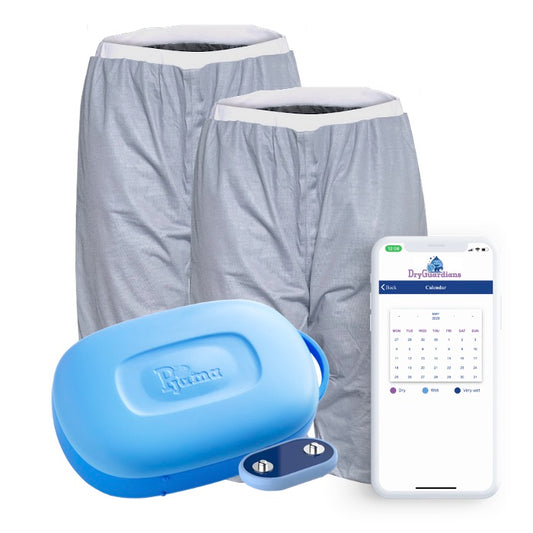-
Pjama Bedwetting Treatment KIT - Boxer Underwear (dark blue) & Alarm
4.67 / 5.0
(3) 3 total reviews
Regular price From $227.00 AUDRegular priceUnit price / per$227.00 AUDSale price From $227.00 AUD -
Pjama Bedwetting Treatment KIT - Unisex Briefs Underwear (purple) & Alarm
Regular price From $227.00 AUDRegular priceUnit price / per$227.00 AUDSale price From $227.00 AUD -
Pjama Bedwetting Treatment Kit - Alarm & Shorts (GREY) Children
4.0 / 5.0
(1) 1 total reviews
Regular price From $415.00 AUDRegular priceUnit price / per$415.00 AUDSale price From $415.00 AUD -
Pjama Bedwetting Treatment Kit - Alarm & Pants (GREY) Children
4.5 / 5.0
(4) 4 total reviews
Regular price From $415.00 AUDRegular priceUnit price / per$415.00 AUDSale price From $415.00 AUD -
Pjama Bedwetting Alarm
5.0 / 5.0
(1) 1 total reviews
Regular price $139.00 AUDRegular priceUnit price / per$139.00 AUDSale price $139.00 AUD -
Pjama Connect Bedwetting Alarm
Regular price $119.00 AUDRegular priceUnit price / per$119.00 AUDSale price $119.00 AUD -
 Sold out
Sold outPjama Sensor
Regular price $69.00 AUDRegular priceUnit price / per -
Pjama Connect Bedwetting Alarm with Speaker
Regular price $199.00 AUDRegular priceUnit price / per$199.00 AUDSale price $199.00 AUD -
Pjama Speaker
Regular price $89.00 AUDRegular priceUnit price / per
Collection: Bed Wetting Alarms
Bed wetting alarms are a common and effective treatment for nocturnal enuresis, often referred to as bedwetting. These devices work by detecting moisture on the child's undergarments and triggering an alarm to wake them up before they completely wet the bed. This allows the child to learn to recognize the sensations of a full bladder and respond by going to the toilet..
How Bed Wetting Alarms Work:
Sensor: A moisture sensor, usually a clip-on device or stand alone sensor, is attached to the child's underwear or nappy.
Alarm: The sensor is connected to an alarm unit or speaker, which can be a small wearable device or a larger bedside unit.
Activation: When the sensor detects moisture and the child starts urinating, it triggers the alarm to go off.
Awakening: The alarm wakes the child up, alerting them that they should go to the toilet.
Toilet trip: The child then goes to the toilet to urinate and empty the bladder
Types of Bed Wetting Alarms:
Pad and Bell Alarms:
How it works:
A sensor pad is placed under the child's bottom sheet, connected to an alarm unit. When moisture is detected, the alarm sounds.
Advantages:
- Easy to set up and use.
- No direct contact with the child's body, reducing discomfort.
Disadvantages:
- Can be less effective for children who wet the bed before the alarm can activate.
- Requires changing the sheets if the child wets the bed.
Body-Worn Alarms:
How it works:
A small sensor is attached to the child's underwear, connected to an alarm unit worn on the body. When moisture is detected, the alarm sounds.
Advantages:
- Detects moisture as soon as it occurs, increasing the chances of waking the child.
- Can be more discreet than pad and bell alarms.
Disadvantages:
- May cause discomfort for some children.
- Requires changing the underwear if the child wets the bed.
Additional Considerations:
- Sound Level: Some alarms have adjustable sound levels to be adjusted to the individual child making sure the child will wake up when they hear the sound
- Vibration Feature: Some alarms also have a vibration feature in addition to sound, which can be helpful for children who are deep sleepers.
- Wireless vs. Wired: Wireless alarms are easier to use for the child but can cost more than a wired bed wet alarm
Choosing the Right Alarm:
The best type of bed wetting alarm for your child will depend on their individual needs and preferences. Consider factors such as their age, sleep patterns, and any sensitivities to noise or touch.
Benefits of Using a Bed Wetting Alarm:
-
Effective Treatment: Bed wetting alarms have a high success rate, with many children becoming dry within a few weeks of consistent use. But, it can also take a few months to achieve a dry bed so be persistent and do not give up
- Non-Invasive: They are a non-medical, drug-free treatment.
- Improves Self-Esteem: By addressing bed wetting, alarms can boost a child's confidence and self-esteem.
- Teaches Bladder Control: Bedwetting Alarms help children learn to recognise bladder signals and respond appropriately.
Important Considerations:
- Consistency: It's very important to use the alarm consistently every night for optimal results.
-
Patience: Progress may take time, and setbacks are common. Do not give up but do not keep going for months if there is no progress, i.e. no dry nights
- Positive Reinforcement: Encourage and reward the child for each dry night.
-
Professional Guidance: Consult with a healthcare provider, e.g. continence nurse, paediatrician, occupational therapist, physiotherapist, or urologist, for personalised advice and support. A healthcare professional can help to determine the most appropriate treatment plan.
Bed wetting alarms offer a reliable and effective solution for children struggling with bedwetting. With patience and consistent use, they can help children achieve night-time dryness and improve their overall well-being.
















